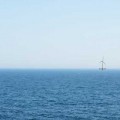The answer to this FAQ was provided by Maine Aqua Ventus. The acoustic modeling study cited in this blog is available here.
In order to assess the potential for noise to reach the island, Maine Aqua Ventus consulted with the Pacific Northwest National Laboratory (PNNL), a US Department of Energy Laboratory that specializes in assessing environmental impacts of renewable energy projects. PNNL used the WindPRO Decibel software package to estimate the sound signature and how loud the turbines at the test site would as heard from Monhegan Island 2.5 miles away. Acoustic information is limited for the 6 MW turbines proposed for the Maine Aqua Ventus project and is not currently in the WindPRO database; however source level information from the turbine manufacturer was available. For this analysis, that information and characteristics of three similar large offshore wind turbines (5 MW to 7.5 MW) were used to model the potential acoustic fields. The model results include atteuation over distance and from atmospheric absorption with receivers downwind from turbines and water treated as an acoustically hard surface with no attenuation or energy absorption by the ocean. These assumptions would likely result in an overestimate of the received sound pressure level at Monhegan Island. The project is pursuing additional turbine sound measurements over ocean water to confirm these model predictions.
The modeled values for sound pressure levels are for the southern tip of the island (Table 3-10)(Whiting et al. 2013).
Table 3-10. Wind Turbines and Modeled Sound Pressure Level Output.
|
Wind Turbine |
Drive Train |
Sound Pressure Level |
| 5 MW REpower | Gear Box | 20.4 dB(A) |
| 7.5 MW ENERCON | Direct Drive | 21.9 dB(A) |
| 7.5 MW adapted ENERCON | Direct Drive | 29.4 dB(A) |
Source: Whiting et al. 2013
The model predicts that the sound pressure level from the 6 MW turbines would be approximately 20 to 29 dB(A) near the southern tip of Monhegan Island. The sound level would be slightly lower at the center and northern portions of the island. Ambient measurements in Maine show that the lower range of the model predictions is similar to ambient sound levels at the quietest rural areas of the State. These model estimates are also well below the State of Maine nighttime sound level limit of 42 dBA that applies to inland wind energy projects and well below the World Health Organization’s recommendation for maximum night time noise levels in Europe (40 dB(A)) (World Health Organization 2009). It is possible that the turbines may be audible under certain meteorological conditions (e.g. down wind, stable atmosphere, temperature inversion) with the turbines operating at full rotational speed while surface winds and ocean waves on Monhegan are light. Locations where turbine sound may be audible at certain times would likely be at higher elevations screened from wave action.
In summary, the sound from the wind turbines reaching Monhegan Island would generally be inaudible with some potential to be audible in certain locations under specific meteorological and ocean conditions. Noise from wind turbines will be commonly masked by wave action on the shoreline and by ambient noise from wind and other sources.
Maine Aqua Ventus is planning to conduct ambient sound monitoring on Monhegan Island to establish baseline sound levels including noise from the existing diesel generator station. These results will enable comparisons of existing ambient sound levels with estimated sound levels from wind turbines. The results could also be used to determine potential noise reduction on the island if diesel generation were reduced or halted as a result of the Aqua Ventus project.
— Maine Aqua Ventus


